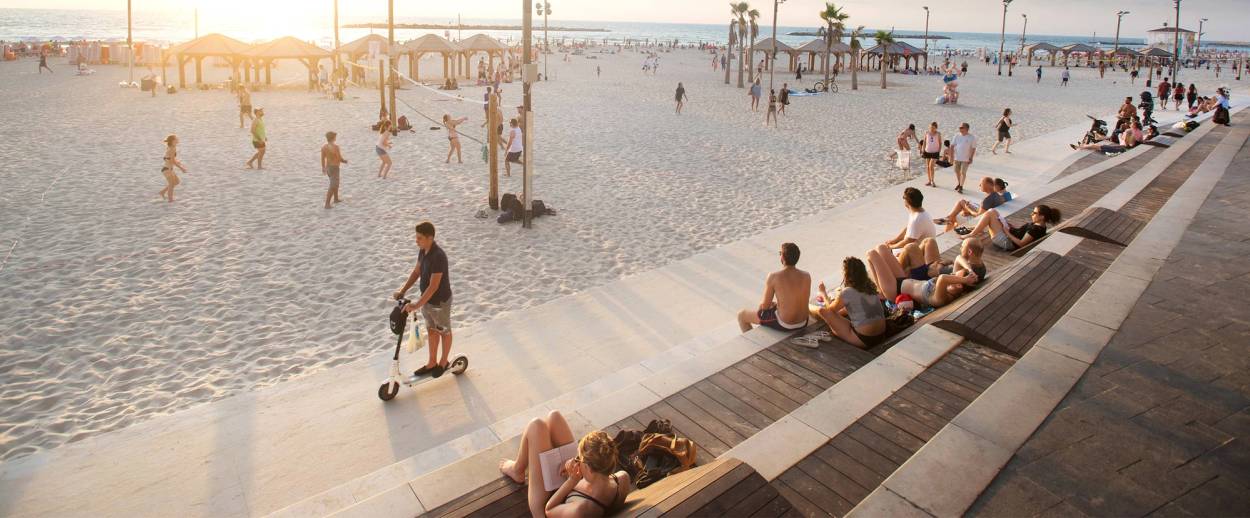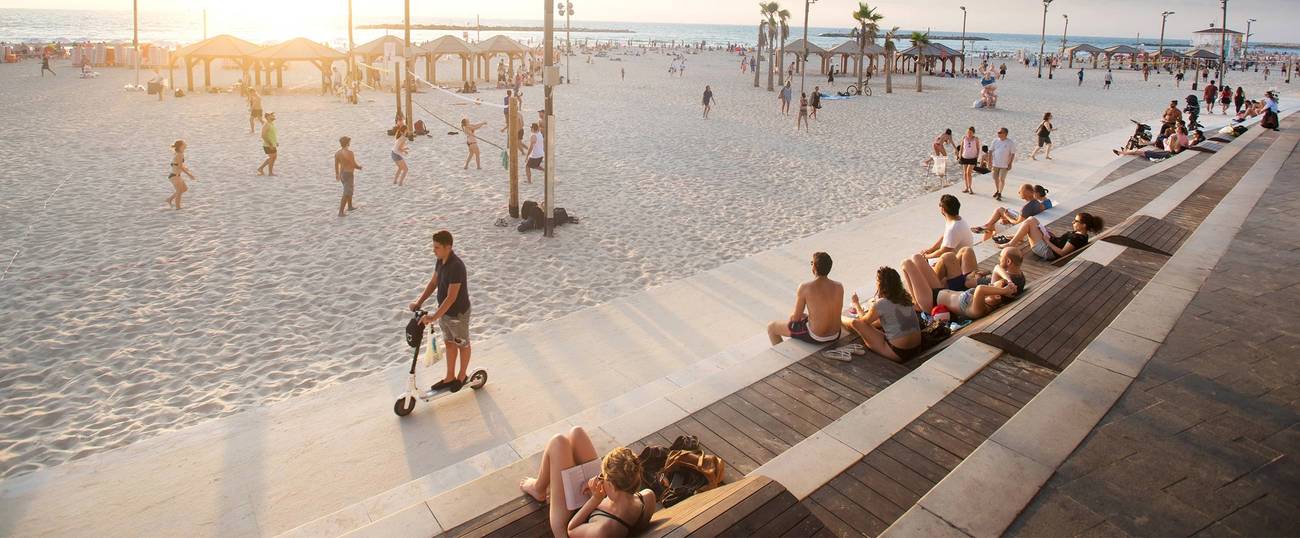The Tide Turns for Tel Aviv’s Beach Promenade
A new look and string of trendy businesses draw locals and tourists alike




Until recently, Tel Aviv’s seaside promenade, the tayelet, wouldn’t have made iconic boardwalk history. Architecturally archaic and lonesome, it’s been, for decades, considered a tourist trap and a place that no self-respecting Tel Avivian would agree to visit. Things are changing, however—and in true Tel Aviv fashion, they’re changing rapidly. Featuring boutique hotels, trendy restaurants and cocktail bars, and a completely new vibe, the tayelet is finally getting hot.
Stretching along the Mediterranean from the old port in Jaffa in the south to the new port in Tel Aviv in the north, this area wasn’t always a promenade. Over the years the beachfront’s destiny had been in the hands of many different authorities, changing its nature with every new policy decision. In the 1920s, the beach potential was first discovered by Tel Avivians; a casino operated in the area, and coffee shops flourished, with public spaces gradually expanding. Back then, Chaim Nachman Bialik, the iconic poet and bohemian, famously compared Tel Aviv to the Ukranian beachtown of Odessa, praising Tel Aviv’s proximity to the Mediterranean and igniting interest in this urban possibility. Parts of the Tel Aviv seashore historically served as a port, but then were a port no longer, with the opening of the bigger Ashdod port in 1965. Beaches were open to the public but then closed in the wake of WWII, and again, years later, due to health risks, as manufacturing facilities around the shoreline contaminated the waters. Parts of the seaside neighborhoods were refurbished and other parts destroyed. In the 1970s and ’80s, a few attempts to make the beach area attractive to the locals once more were made, with the launch of the Charles Clore Park in the south, and in 1982, the reopening of a refurbished, widened version of the old segmented boardwalk, championed by former Tel Aviv Mayor Shlomo Lahat. New gathering spaces and businesses rose, promising a bright future. When Lahat participated in a ceremony honoring Jerusalem’s Mayor Teddy Kollek, he gave Kollek, his mentor, the gift of naming part of the new tayelet Jerusalem Beach.
But come the ’90s and early 2000s, the whole area came to be perceived, especially by locals, as inferior to the buzzing Rothschild Boulevard and the up-and-coming Florentin neighborhood. Lacking cultural landmarks and worthy eateries, and hosting primarily old-school hotels catering to wealthy retirees, Tel Aviv’s prime sliver of real estate was forgotten by the city’s own residents. Made from granulite, with its uneven texture, and outfitted with wooden, brown gazebos, the tayelet looked outdated and unattractive, and the surrounding buildings and institutions felt the same, removed from the city’s everyday life. In the center of the strip, Kikar Atarim, a large, impressive concrete construction looking at the beach, hosted questionable businesses and harbored crime. It was described in the 2004 Shimon Adaf detective novel, One Mile and Two Days Before Sunset, as “a remnant of a luxurious past that never was.”
But in 2012, the tide turned: Ron Huldai, the mayor of Tel Aviv-Jaffa since 1998, initiated the project that would bring the promenade into the 21st century. Atarim, the company officially responsible for the maintenance and development of the city’s beach area, tapped Mayslits Kassif Architects, the firm responsible for the successful transformation of the Tel Aviv port into a walkable shopping and leisure zone in 2003, for a plan to renew the promenade. In 2018, the ambitious undertaking was finished. “The old promenade was starting to look neglected and frumpy,” said the firm’s co-founder Udi Kassif. “One of the promenade’s main problems was the separation of the beach from the actual walking area with a steep wall, making the beach inaccessible. We created an inviting in-between zone, where people can lounge and be by the beach, in the city.” The uneven, stroller- and bike-unfriendly granulite was replaced by a smoother surface. And wooden steps, which Kassif calls “a hospitable space that makes you feel welcome and offers you plenty of interaction options,” were added, blending the boardwalk with the sand and the public sphere in a seamless, laid-back way.
“They really opened the beach up to the people,” longtime Tel Aviv resident Adi Bussiba told me on a recent afternoon, when she was lounging on the steps with her young children. “We come to the tayelet much more frequently now because it’s easy.”
According to Kassif, the project massively shifted the public’s approach to the area. Around the tayelet’s awakening, fashionable businesses have started to open along nearby HaYarkon and Ben Yehuda Streets, a neighborhood previously unthinkable for the cool urban entrepreneurs. The pioneer was Imperial, a sophisticated and award-winning cocktail bar that opened near the American Embassy in 2013 and drew new crowds closer to the waves. Earlier this year, the beach-adjacent Bar 51 had become the trendiest place in town, located in the Renoma boutique hotel and serving small dishes and an interesting wine list. Chef Omer Miller opened his popular beachside restaurant Calypso two years ago, and last year, Fantastic TLV sealed the deal as far as “it” factor goes; designed as an Alice in Wonderland-esque experience, with a tearoom, a “ballroom,” and soon a separate space for brunch, the eccentric establishment is viewed by some as Tel Aviv’s answer to Sketch, the Instagrammable London must-visit restaurant. While a few years ago a place like this could have existed only in the city’s beating heart, Fantastic opened its doors on the edge of the new Tel Aviv port, on a corner of HaYarkon. “The overall improvement of the tayelet brought an improved atmosphere to the whole city, which sends tourists home happy,” said Ariel Leizgold, co-owner of Fantastic TLV and other Tel Aviv establishments. “It’s a natural thing, such as improving infrastructure—bettering the beachside experience.”
Brown Hotels, an international brand founded in Tel Aviv by hotelier Leon Avigad, has also contributed significantly to the tayelet’s rising sex appeal, in the eyes of tourists and locals alike. In 2015, the brand opened Brown Beachhouse, a boutique hotel on HaYarkon Street, and in 2018, Brown Lighthouse on Ben Yehuda joined the chain. Featuring a rooftop bar hosting weekly parties for locals and hotel guests, and equipped with a relaxing terrace where a lavish breakfast is served, the Lighthouse infuses new life into the previously overlooked corner of two busy, gritty streets. While talking about the tayelet, Avigad enthusiastically mentioned Venice Beach, Rio de Janeiro, and other world-class boardwalks. “Every time we open in an area, we feel a positive change,” he said. “There’s something to be said about the cool effect, and it’s great for both locals and tourists. The modern-day traveler wants to be where the locals are, so it’s critical for us to attract Tel Avivians.”
Soon, Brown Hotels will open a new property in the same area, while David Promenade Residences and David Kempinski are slated to open later this year closer to Jaffa. “The city is developing on its own, it’s all grassroots,” Avigad said of the changes happening around the tayelet. “Once the tayelet was for tourists, but lately places are opening for the locals, and tourists follow suit.”
Needless to say, the “locals” aren’t what they used to be in 1930; capturing the attention of the choosy, cosmopolitan Tel Avivian in 2019 is harder than it was years ago, and much harder than selling a wide-eyed visitor an overpriced falafel pita on the beach. And yet, with a new look and feel, the tayelet is succeeding once again, and this time it seems permanent.
***
Like this article? Sign up for our Daily Digest to get Tablet magazine’s new content in your inbox each morning.
Flora Tsapovsky is a San Francisco-based food and culture writer.